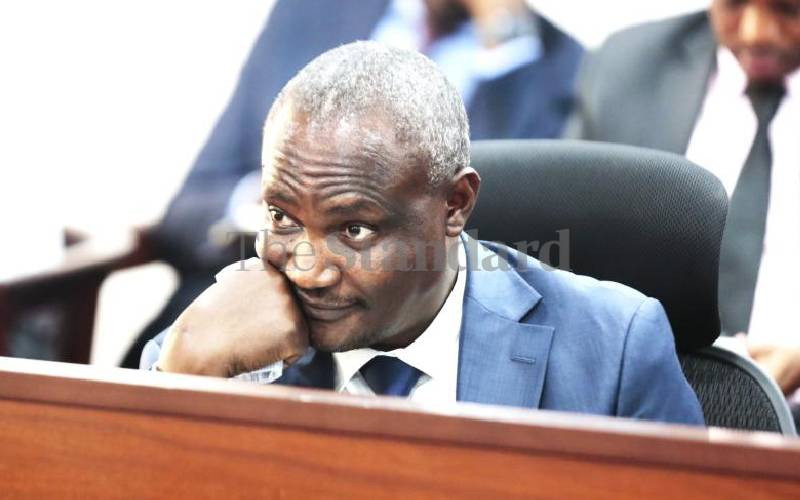Personal emoluments—allowances and salaries still constitute a chunk of the Government’s recurrent spending, a new report by the Office of the Controller of Budget (COB) shows.
This is despite the directive by President Uhuru Kenyatta that Cabinet Secretaries, Principal Secretaries and Parastatal chiefs take a 20 per cent pay cut to contain the spiralling wage bill.
According to the Controller of Budget report, total recurrent expenditure by ministries, departments and agencies in the first quarter of 2014/15 financial year stood at Sh133.7 billion, with personnel emoluments amounting to Sh58.4 billion. This is about 51.9 per cent of the total recurrent expenditure while operations and maintenance took Sh56 billion, which is 48.1 per cent of the total recurrent expenditure.
The National Government’s Budget Implementation Review Report for period July 1 to September 30, 2014, total development expenditure for the period was Sh55.3 billion, representing an absorption rate of 11.2 per cent of the annual development budget. This was, however, an improvement from the first quarter of financial year 2013/14 where Sh36 billion (absorption rate of 8.1 per cent) was spent on development activities.
According to the report, total expenditure for Consolidated Fund Services (CFS) amounted to Sh142.7 billion, with an absorption rate of 34.3 per cent, a significant increase from Sh29.5 billion —absorption rate of 7.7 per cent, recorded in the same period during last financial year (2013/14).
According to the report, overall budget implementation in the first quarter of 2014/15 showed an increase in development expenditure and a marginal decline in recurrent expenditure compared to the same period in the last financial year.
The absorption of development funds increased from the 8.1 per cent in 2013/14 financial year to the current 11.2 per cent while absorption of recurrent expenditure declined to 19.4 per cent from the 22.8 per cent recorded in the first quarter of 2013/14.
Professional services
The highest development expenditure was the transfers to national government entities of Sh33.6 billion accounting for 60.2 per cent of the total ministries, departments and agencies development spending followed by expenditure on refurbishment of buildings, infrastructure works, and civil works at Sh19 billion or 34 per cent.
The categories with the least expenditure were maintenance of assets and motor vehicles at Sh157.1 million and Sh7 million, respectively, accounting for 0.3 per cent and 0.01 per cent of the total development expenditure.
Expenditure on contracted technical and professional services accounted for Sh268.6 million or 0.5 per cent of the total development expenditure.
The ministry of Information & Communication and Technology spent Sh211.1 million, the highest under this category representing 78 per cent of the total expenditure in this category.
The State department for Infrastructure had the highest capital transfers to its Semi-Autonomous Government Agencies amounting to Sh15.4 billion. This was 46 per cent of the total spending in this category.
The State Department for Transport spent Sh10 billion on refurbishment of buildings, infrastructure and civil works representing 53 per cent of the Sh19 billion spent in this category. According to the report, the Energy, Infrastructure and information, Communication and Technology Sector spent a total of Sh32.7 billion to implement its 17 programmes, achieving an absorption rate of 13 per cent.
The sector’s recurrent expenditure amounted to Sh7.5 billion (23 per cent of total expenditure) while Sh25.2 billion (77 per cent) was spent on development projects.
Stay informed. Subscribe to our newsletter
The rail transport programme recorded the highest absorption rate at 31 per cent. About 50 per cent of the programmes recorded absorption rate below 10 per cent.
Loans and grants
In the 2014/15 financial year, the national government has a total budget of Sh1.84 trillion comprising of Sh242.4 billion allocation to County Governments, Sh415.6 billion to the Consolidated Fund Services, Sh687.2 billion, and Sh.494.9 billion for recurrent and development activities, respectively.
The development allocation comprised of Sh307.1 billion to be funded from domestic resources while Sh187.8 billion was to be funded from project loans and grants mobilised externally. At least 30 percent of the National Budget was allocated to development expenditure in line with the fiscal responsibility principles outlined in the Public Finance Management Act (PFMA), 2012.
The Kenya Revenue Authority (KRA) projected to collect Sh1. 05 trillion in 2014/15 with the first quarter target being Sh267 billion or 23.8 per cent of the annual projection.
However, actual collections amounted to Sh249.1billion representing 93.3 per cent of the quarter’s target.
In order to supplement resources mobilised locally to finance development activities in 2014/15, the Government anticipates raising Sh187.8 billion from development partners through loans and grants.
Actual performance for this category in the first quarter was Sh14.8 billion representing 7.92 per cent of the annual printed estimates.
 The Standard Group Plc is a
multi-media organization with investments in media platforms spanning newspaper
print operations, television, radio broadcasting, digital and online services. The
Standard Group is recognized as a leading multi-media house in Kenya with a key
influence in matters of national and international interest.
The Standard Group Plc is a
multi-media organization with investments in media platforms spanning newspaper
print operations, television, radio broadcasting, digital and online services. The
Standard Group is recognized as a leading multi-media house in Kenya with a key
influence in matters of national and international interest.
 The Standard Group Plc is a
multi-media organization with investments in media platforms spanning newspaper
print operations, television, radio broadcasting, digital and online services. The
Standard Group is recognized as a leading multi-media house in Kenya with a key
influence in matters of national and international interest.
The Standard Group Plc is a
multi-media organization with investments in media platforms spanning newspaper
print operations, television, radio broadcasting, digital and online services. The
Standard Group is recognized as a leading multi-media house in Kenya with a key
influence in matters of national and international interest.









